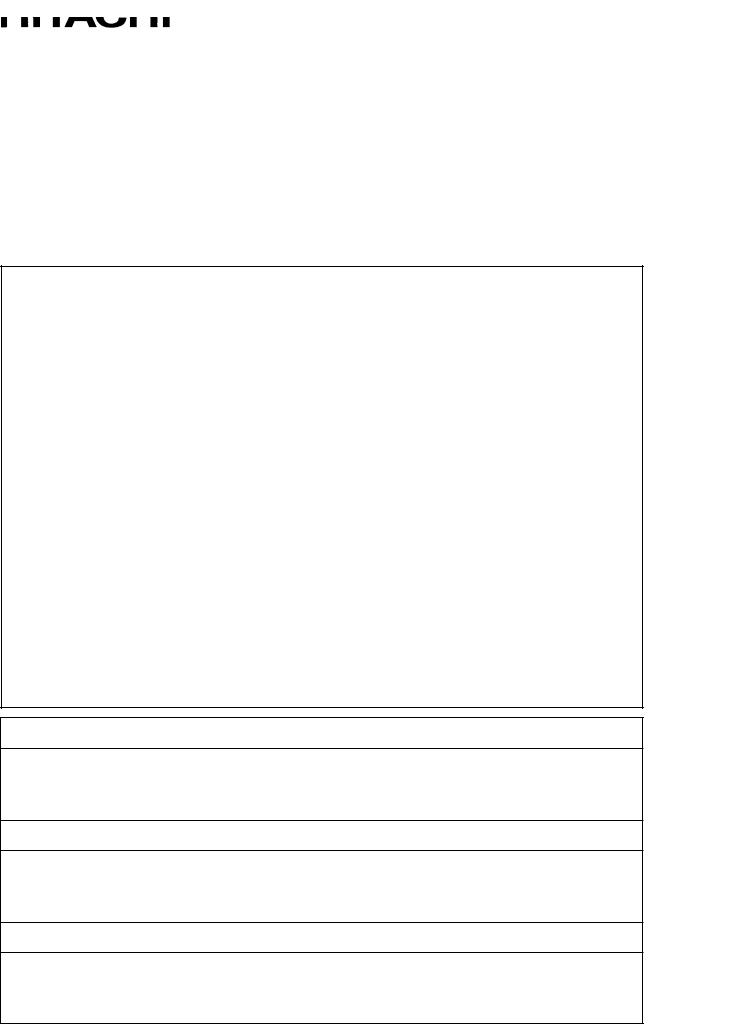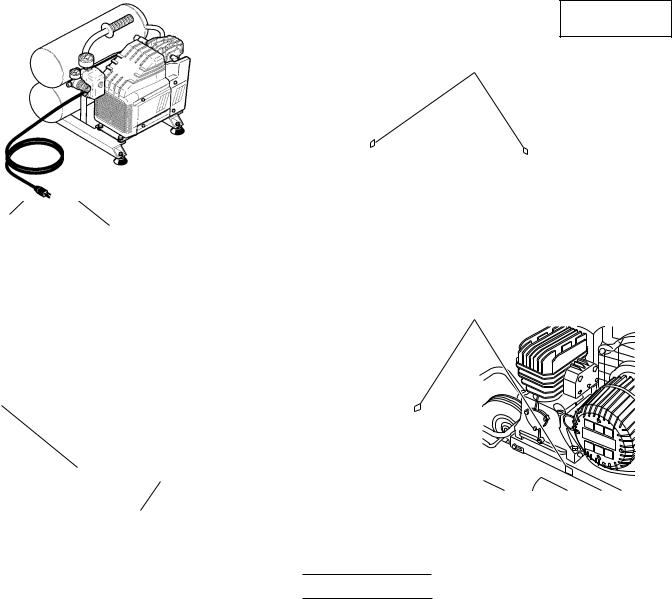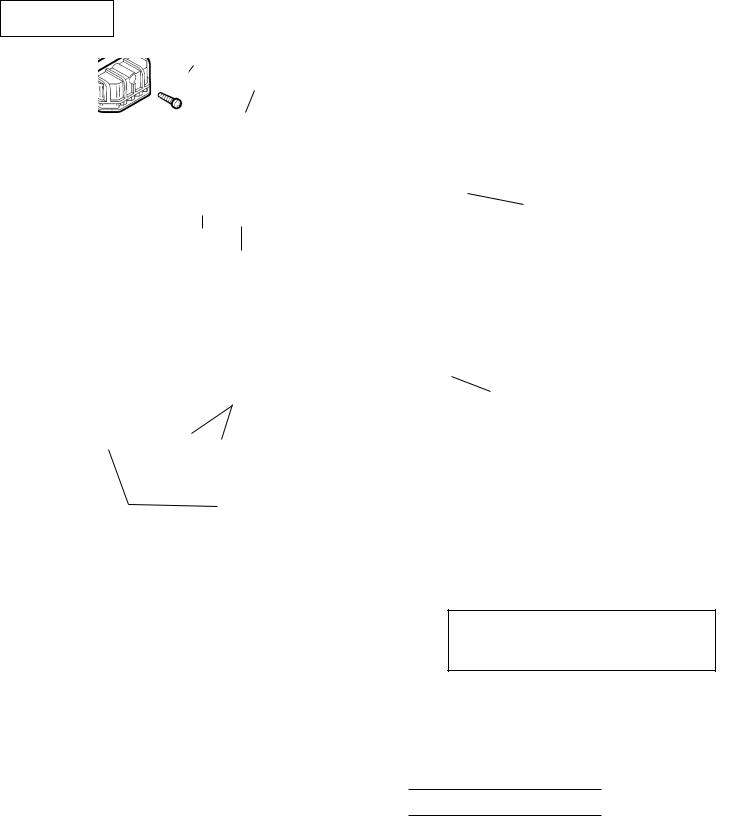Hitachi EC 6B, EC 6C, EC 12, EC 16 User Manual

English
POWER TOOLS
INSTRUCTION MANUAL AND SAFETY INSTRUCTIONS FOR AIR COMPRESSOR MANUEL D’UTILISATION ET CONSIGNES DE SÉCURITÉ DU COMPRESSEUR MANUAL DE INSTRUCCIONES Y INSTRUCCIONES DE SEGURIDAD PARA EL COMPRESOR DE AIRE
MODEL |
EC 6B EC 6C EC 12 EC 16 |
MODÈLE |
|
MODELO |
|
EC6B
EC12
 WARNING
WARNING
Improper and unsafe use of this compressor can result in death or serious bodily injury!
This manual contains important information about product safety.
Please read and understand this manual before operating the compressor.
Please keep this manual available for others before they use the compressor.
 AVERTISSEMENT
AVERTISSEMENT
Une utilisation du compresseur de manière incorrecte ou ne respectant pas les consignes de sécurité peut entraîner la mort ou de graves blessures!
Ce manuel renferme des informations importantes relatives à la sécurité.
Veuillez lire attentivement toutes les instructions avant de mettre le compresseur en service. Laissez ce manuel à la disposition des personnes qui vont utiliser le compresseur.
 ADVERTENCIA
ADVERTENCIA
¡La utilización inadecuada e insegura de este compresor puede resultar en la muerte o en lesiones serias! Este manual contiene información importante sobre la seguridad del producto.
Antes de utilizar el compresor, lea y entienda bien este manual.
Guarde este manual as mano para que otras personas puedan leerlo antes de utilizar el compresor.
— 1 —

English
— C O N T E N T S —
English
|
Page |
IMPORTANT INFORMATION ............................... |
3 |
MEANINGS OF SIGNAL WORDS ........................ |
3 |
SAFETY |
|
IMPORTANT SAFETY INSTRUCTIONS |
|
FOR USE OF THE COMPRESSOR ........ |
4 |
REPLACEMENT PARTS ........................................ |
5 |
GROUNDING INSTRUCTIONS ............................ |
6 |
EXTENSION CORD ............................................... |
6 |
|
Page |
OPERATION AND MAINTENANCE |
|
NAME OF PARTS .................................................. |
8 |
SPECIFICATIONS .................................................. |
9 |
ACCESSORIES ...................................................... |
9 |
APPLICATIONS ..................................................... |
9 |
PRIOR TO OPERATION ....................................... |
10 |
OPERATION ........................................................ |
10 |
MAINTENANCE .................................................. |
11 |
SERVICE AND REPAIRS ..................................... |
12 |
PARTS LIST ......................................................... |
34 |
— T A B L E D E S M A T I È R E S —
Français
|
Page |
IINFORMATIONS IMPORTANTES ........................... |
13 |
SIGNIFICATION DU VOCABULAIRE DE |
|
SIGNALISATION ................................. |
13 |
SÉCURITÉ |
|
CONSIGNES DE SÉCURITÉ IMPORTANTES |
|
POUR L’UTILISATION DU COMPRESSEUR .. |
14 |
PIÈCES DE RECHANGE ...................................... |
15 |
INSTRUCTIONS DE MISE À LA TERRE ............. |
16 |
CORDON DE RALLONGE ................................... |
16 |
|
Page |
UTILISATION ET ENTRETIEN |
|
NOM DES PIÈCES ............................................... |
18 |
FICHE TECHNIQUE ............................................. |
19 |
ACCESSOIRES .................................................... |
19 |
APPLICATIONS ................................................... |
19 |
AVANT L’UTILISATION ...................................... |
20 |
UTILISATION ....................................................... |
20 |
ENTRETIEN ......................................................... |
21 |
SERVICE APRÈS-VENTE ET RÉPARATIONS ..... |
22 |
LISTE DES PIÉCES .............................................. |
34 |
— Í N D I C E —
Español
Página |
|
INFORMACIÓN IMPORTANTE ................................ |
23 |
SIGNIFICADO DE LAS PALABRAS DE |
|
SEÑALIZACIÓN ................................... |
23 |
SEGURIDAD |
|
INSTRUCCIONES IMPORTANTES DE SEGURIDAD |
|
PARA LA UTILIZACIÓN DEL COMPRESOR ...... |
24 |
PIEZAS DE REEMPLAZO .................................... |
25 |
INSTRUCCIONES PARA LA PUESTA A TIERRA .. |
26 |
CABLE PROLONGADOR ..................................... |
26 |
|
Página |
OPERACIÓN Y MANTENIMIENTO |
|
NOMENCLATURA .............................................. |
28 |
ESPECIFICACIONES ........................................... |
29 |
ACCESORIOS ...................................................... |
29 |
APLICACIONES ................................................... |
29 |
ANTES DE LA OPERACIÓN ................................ |
30 |
OPERACIÓN ........................................................ |
30 |
MANTENIMIENTO .............................................. |
31 |
SERVICIO Y REPARACIONES ............................ |
32 |
LISTA DE PIEZAS ................................................ |
34 |
— 2 —

English
IMPORTANT INFORMATION
Read and understand all of the operating instructions, safety precautions and warnings in the Instruction Manual before operating or maintaining this compressor.
Most accidents that result from compressor operation and maintenance are caused by the failure to observe basic safety rules or precautions. An accident can often be avoided by recognizing a potentially hazardous situation before it occurs, and by observing appropriate safety procedures.
Basic safety precautions are outlined in the “SAFETY” section of this Instruction Manual and in the sections which contain the operation and maintenance instructions.
Hazards that must be avoided to prevent bodily injury or machine damage are identified by WARNINGS on the compressor and in this Instruction Manual.
Never use this compressor in a manner that has not been specifically recommended by HITACHI, unless you first confirm that the planned use will be safe for you and others.
MEANINGS OF SIGNAL WORDS
WARNING indicates a potentially hazardous situations which, if ignored, could result in serious personal injury.
CAUTION indicates a hazardous situations which, if ignored, could result moderate personal injury, or could cause machine damage.
NOTE emphasizes essential information.
— 3 —

English
SAFETY
IMPORTANT SAFETY INSTRUCTIONS
FOR USE OF THE COMPRESSOR
 WARNING: Death or serious bodily injury could result from improper or unsafe use of compressor. To avoid these risks, follow these basic safety instructions:
WARNING: Death or serious bodily injury could result from improper or unsafe use of compressor. To avoid these risks, follow these basic safety instructions:
READ ALL INSTRUCTIONS
1.NEVER TOUCH MOVING PARTS.
Never place your hands, fingers or other body parts near the compressor’s moving parts.
2.NEVER OPERATE WITHOUT ALL GUARDS IN PLACE.
Never operate this compressor without all guards or safety features in place and in proper working order. If maintenance or servicing requires the removal of a guard or safety features, be sure to replace the guard or safety features before resuming operation of the compressor.
3.ALWAYS WEAR EYE PROTECTION.
Always wear safety goggles or equivalent eye protection. Compressed air must never be aimed at anyone or any part of the body.
4.PROTECT YOURSELF AGAINST ELECTRIC SHOCK.
Prevent body contact with grounded surfaces such as pipes, radiators, ranges and refrigeration enclosures. Never operate the compressor in damp or wet locations.
5.DISCONNECT THE COMPRESSOR.
Always disconnect the compressor from the power source and remove the compressed air from the air tank before servicing, inspecting, maintaining, cleaning, replacing or checking any parts.
6.AVOID UNINTENTIONAL STARTING.
Do not carry the compressor while it is connected to its power source or when the air tank is filled with compressed air. Be sure the knob of the pressure switch in the “OFF” position before connecting the compressor to its power source.
7.STORE COMPRESSOR PROPERLY.
When not in use, the compressor should be stored in a dry place. Keep out of reach of children. Lock-out the storage area.
8.KEEP WORK AREA CLEAN.
Cluttered areas invite injuries. Clear all work areas of unnecessary tools, debris, furniture, etc.
9.CONSIDER WORK AREA ENVIRONMENT.
Don’t expose compressor to rain. Don’t use compressor in damp or wet locations. Keep work area well lit and well ventilated.
Don’t use compressor in the presence of flammable liquids or gases.
Compressor produces sparks during operation. Never use compressor in sites containing lacquer, paint, benzine, thinner, gasoline, gases, adhesive agents, and other materials which are combustible or explosive.
10.KEEP CHILDREN AWAY.
Do not let visitors contact compressor extension cord. All visitors should be kept safely away from work area.
11.DRESS PROPERLY.
Do not wear loose clothing or jewelry. They can be caught in moving parts.
Wear protective hair covering to contain long hair.
12.DON’T ABUSE CORD.
Never yank it to disconnect from receptacle. Keep cord from heat, oil and sharp edges.
.
13.MAINTAIN COMPRESSOR WITH CARE.
Follow instructions for lubricating.
Inspect cords periodically and if damaged, have repaired by authorized service center. Inspect extension cords periodically and replace if damaged.
14.OUTDOOR USE EXTENSION CORDS.
When compressor in used outdoors, use only extension cords intended for use outdoors and so marked.
15.STAY ALERT.
Watch what you are doing. Use common sense. Do not operate compressor when you are tired. Compressor should never be used by you if you are under the influence of alcohol, drugs or medication that makes you drowsy.
16.CHECK DAMAGED PARTS AND AIR LEAK.
Before further use of the compressor, a guard or other part is damaged should be carefully checked to determine that it will operate properly and perform its intended function. Check for alignment of moving parts, binding of moving parts, breakage of parts, mounting, air leak, and any other conditions that may affect its operation.
A guard or other part that is damaged should be properly repaired or replaced by an authorized service center unless otherwise indicated elsewhere in this Instruction Manual.
— 4 —

Have defective pressure switches replaced by authorized service center.
Do not use compressor if switch does not turn it on and off.
17.NEVER USE COMPRESSOR FOR APPLICATIONS OTHER THAN THOSE SPECIFIED.
Never use compressor for applications other than those specified in the Instruction Manual.
18.HANDLE COMPRESSOR CORRECTLY.
Operate the compressor according to the instructions provided herein. Never allow the compressor to be operated by children, individuals unfamiliar with its operation or unauthorized personnel.
19.KEEP ALL SCREWS, BOLTS AND COVERS TIGHTLY IN PLACE.
Keep all screws, bolts, and covers tightly mounted. Check their conditions periodically.
20.KEEP MOTOR AIR VENT CLEAN.
The motor air vent must be kept clean so that air can freely flow at all times. Check for dust build-up frequently.
21.OPERATE COMPRESSOR AT THE RATED VOLTAGE.
Operate the compressor at voltages specified on their nameplates.
If using the compressor at a higher voltage than the rated voltage, it will result in abnormally fast motor revolution and may damage the unit and burn out the motor.
22.NEVER USE A COMPRESSOR WHICH IS DEFECTIVE OR OPERATING ABNORMALLY.
If the compressor appears to be operating unusually, making strange noises, or otherwise appears defective, stop using it immediately and arrange for repairs by a Hitachi authorized service center.
23.DO NOT WIPE PLASTIC PARTS WITH SOLVENT.
Solvents such as gasoline, thinner, benzine, carbon tetrachloride, and alcohol may damage and crack plastic parts. Do not wipe them with such solvents. Wipe plastic parts with a soft cloth lightly dampened with soapy water and dry thoroughly.
English
24.USE ONLY GENUINE HITACHI REPLACEMENT PARTS.
Replacement parts not manufactured by Hitachi may void your warranty and can lead to malfunction and resulting injuries. Genuine Hitachi parts are available from your dealer.
25.DO NOT MODIFY THE COMPRESSOR.
Do not modify the compressor. Always contact the Hitachi authorized service center any repairs. Unauthorized modification may not only impair the compressor performance but may also result in accident or injury to repair personnel who do not have the required knowledge and technical expertise to perform the repair operations correctly.
26.TURN OFF THE PRESSURE SWITCH WHEN THE COMPRESSOR IS NOT USED.
When the compressor is not used, turn the knob of the pressure switch OFF, disconnect it from the power source and open the drain cock to discharge the compressed air from the air tank.
27.NEVER TOUCH HOT SURFACE.
To reduce the risk of burns, do not touch tubes, heads, cylinder and motors.
28.DO NOT DIRECT AIR STREAM AT BODY.
Risk of injury, do not direct air stream at persons or animals.
29.DRAIN TANK.
Drain tank daily or after 4 hours of use. Open drain fitting and tilt compressor to empty accumulated water.
30.DO NOT STOP COMPRESSOR BY PULLING OUT THE PLUG.
Use the “AUTO/OFF” knob of pressure switch.
31.USE ONLY RECOMMENDED AIR HANDLING PARTS ACCEPTABLE FOR PRESSURE NOT LESS THAN 125 PSI (8.6 BAR)
Risk of bursting. Use only recommended air handling parts acceptable for pressures not less than 125 psi (8.6 bar).
REPLACEMENT PARTS
When servicing use only identical replacement parts.
Repairs should be conducted only by a Hitachi authorized service center.
— 5 —

English
SAFETY — Continued
GROUNDING INSTRUCTIONS
This compressor should be grounded while in use to protect the operator from electric shock. The compressor is equipped with a three-conductor cord and three-prong grounding type plug to fit the proper grounding type receptacle. The green (or green and yellow) conductor in the cord is the grounding wire. Never connect the green (or green and yellow) wire to a live terminal. If your unit is for use on less than 150 volts, it has a plug that looks like that shown in sketch (A) in Figure on the right. An adapter, see sketches (B) and (C), is available for connecting sketch (A) type plugs to two-prong receptacles. The green-colored rigid ear, lug, or the like extending from the adapter must be connected to a permanent ground, such as a properly grounded outlet box.
Note: The grounding adaptor, sketch (C), is prohibited in Canada by Canadian Electrical Code Part 1. Therefore, the instructions for its use are not applicable in Canada.
We recommend that you never disassemble the compressor or try to do any rewiring in the electrical system. Any repairs should be performed only by HITACHI Service Centers or other qualified service organizations. Should you be determined to make a repair yourself, remember that the green colored wire is the “grounding” wire. Never connect this green wire to a “live” terminal. If you replace the plug on the power cord, be sure to connect the green wire only to the grounding (longest) prong on a 3-prong plug.
If in doubt, call a qualified electrician and have the receptacle checked for ground.
Ground |
Cover of Grounded |
Blade |
Outlet box |
|
(A) |
Cover of Grounded Outlet box
(B)
Adapter
Grounding Means
(C)
EXTENSION CORD
Use only three-wire extension cords that have three-prong grounding-type plugs and three-pole receptacles that accept the compressor’s plug. Replace or repair damaged cord.
Make sure your extension cord is in good condition. When using an extension cord, be sure to use one heavy enough to carry the current your product will draw. An undersized cord will cause a drop in line voltage resulting in loss of power and overheating. Table shows the correct size to use depending on cord length and name plate ampere rating. If in doubt, use the next heavier gage. The smaller the gage number, the heavier the cord.
MINIMUM GAGE FOR CORD SETS
|
|
|
Total Length of Cord in Feet (Meter) |
|
||
|
|
|
0 – 25 |
26 – 50 |
51 – 100 |
101 – 150 |
|
|
|
(0 – 7.6) |
(7.9 – 15.2) |
(15.5 – 30.5) |
(30.8 – 45.7) |
Ampere |
Rating |
|
AWG |
|
|
|
More |
Not More |
|
|
|
|
|
Than |
Than |
|
|
|
|
|
0 |
– 6 |
18 |
16 |
16 |
14 |
|
6 |
– 10 |
18 |
16 |
14 |
12 |
|
10 |
– 12 |
16 |
16 |
14 |
12 |
|
12 |
– 16 |
14 |
12 |
Not Recommended |
||
— 6 —

English
 WARNING: Avoid electrical shock hazard. Never use this compressor with a damaged or frayed electrical cord or extension cord. Inspect all electrical cords regularly. Never use in or near water or in any environment where electric shock is possible.
WARNING: Avoid electrical shock hazard. Never use this compressor with a damaged or frayed electrical cord or extension cord. Inspect all electrical cords regularly. Never use in or near water or in any environment where electric shock is possible.
SAVE THESE INSTRUCTIONS
AND
MAKE THEM AVAILABLE TO
OTHER USERS OF THIS TOOL!
— 7 —

English
OPERATION AND MAINTENANCE
NOTE:
The information contained in this Instruction Manual is designed to assist you in the safe operation and maintenance of the compressor.
Some illustrations in this Instruction Manual may show details or attachments that differ from those on your own compressor.
NAME OF PARTS
Knob of the pressure switch |
Intake filter |
Knob of the pressure switch |
|
||
Intake filter Head |
|
Knob of the pressure reducer |
Knob of the pressure reducer |
|
|
|
|
Dipstick
Joint
Joint
Tank
Drain cock |
Tank |
Drain cock
(EC6B) |
(EC6C) |
Head |
Intake filter |
Head |
Knob of the pressure switch |
Dipstick |
|
|
Intake filter |
|
|
Dipstick |
|
Tank |
Knob of the pressure |
Tank |
|
||
reducer |
|
|
|
|
|
|
Joint |
|
Joint |
|
|
Knob of the pressure reducer |
Drain cock |
(EC12) |
(EC16) |
Fig. 1
— 8 —

|
|
|
|
|
|
|
|
English |
|
|
|
|
|
|
|
|
|
|
|
|
|
|
|
|
|
|
|
|
|
SPECIFICATIONS |
|
|
|
|
|
|
|||
|
|
|
|
|
|
|
|
|
|
|
|
|
|
|
|
|
|
|
|
Model |
|
|
EC6B |
EC6C |
EC12 |
|
EC16 |
|
|
|
|
|
|
|
|
|
|
|
|
Motor |
|
|
|
Single-Phase, Induction Motor |
|
|
|
||
|
|
|
|
|
|
|
|
|
|
Power Source |
|
|
|
Single-Phase, 115V AC 60Hz |
|
|
|
||
|
|
|
|
|
|
|
|
|
|
Input |
|
|
1 HP |
1 HP |
2 HP |
2 1/2 HP |
|
||
|
|
(0.75 KW) |
(0.75 KW) |
(1.49 KW) |
(1.87 KW) |
|
|||
|
|
|
|
|
|||||
|
|
|
|
|
|
|
|
|
|
Current |
|
|
7.8A |
10.05A |
13.5A |
13.5A |
|
||
|
|
|
|
|
|
|
|
|
|
Tank Capacity |
|
|
3.3 gal. |
3.3 gal. |
4 gal. |
5 gal. |
|
||
|
|
(12.5 ltr) |
(12.5 ltr) |
(15.1 ltr) |
(18.9 ltr) |
|
|||
|
|
|
|
|
|||||
|
|
|
|
|
|
|
|
|
|
Maximum Pressure |
125 PSI |
125 PSI |
125 PSI |
145 PSI |
|
||||
(8.6 bar) |
(8.6 bar) |
(8.6 bar) |
(10.0 bar) |
|
|||||
|
|
|
|
|
|||||
|
|
at 40 PSI |
3.2 CFM |
3.0 CFM |
4.2 CFM |
4.9 CFM |
|
||
|
|
(2.8 bar) |
(91 ltr/min) |
(85 ltr/min) |
(119 ltr/min) |
(130 ltr/min) |
|
||
Free Air |
|
at 90 PSI |
2.5 CFM |
2.4 CFM |
4.1 CFM |
4.8 CFM |
|
||
Delivery |
|
(6.2 bar) |
(71ltr/min) |
(68 ltr/min) |
(116 ltr/min) |
(136 ltr/min) |
|
||
|
|
at 100 PSI |
2.4 CFM |
2.4 CFM |
3.6 CFM |
4.7 CFM |
|
||
|
|
(6.9 bar) |
(68 ltr/min) |
(68 ltr/min) |
(102 ltr/min) |
(133 ltr/min) |
|
||
|
|
|
|
|
|
|
|
|
|
Lubrication |
|
|
Oil |
Oil-less |
Oil |
|
Oil |
|
|
|
|
|
|
|
|
|
|
|
|
ACCESSORIES
 WARNING:
WARNING:
Accessories other than those shown below can lead to malfunction and resulting injuries.
STANDARD ACCESSORIES |
|
|
EC6B |
|
|
|
Dipstick - - - - - - - - - - - - - - - - - - - - - - |
1 |
EC12 |
|
|
EC16 |
Dipstick - - - - - - - - - - - - - - - - - - - - - - |
1 |
EC6C |
No accessories |
|
APPLICATIONS
Air source of the pneumatic nailer and stapler.
— 9 —

English
PRIOR TO OPERATION
1. Power source
Ensure that the power source to be utilized conforms to the power source requirements specified on the product nameplate.
2. Power switch
Ensure that the knob of the pressure switch is in the “OFF” position. If the plug is connected to a receptacle while the knob is in the “AUTO” position, the compressor will start operating immediately and can cause serious injury.
3. Extension cord
When the work area is far away from the power source, use an extension cord of sufficient thickness and rated capacity (refer page 6). The extension cord should be kept as short as practicable.
 WARNING: Damaged cord must be replaced or repaired.
WARNING: Damaged cord must be replaced or repaired.
Dipstick
|
MAX. |
|
MIN. |
(EC12EC6B ) |
(EC16) |
|
Fig. 3 |
When the oil volume is insufficient, refer to the section “Oil change-oil topping off” on page 12 for a description of how to supply the oil.
6. Air coupler installation
Screw in the air coupler to the joint (Refer to Fig. 1 and Fig. 4.). The screw size of the joint is 3/8". Use an air coupler which has the same screw size.
4. Confirm the power receptacle
If the power receptacle only loosely accepts the plug, the receptacle must be repaired. Contact the nearest electric store for repair service.
If such a faulty receptacle is used, may cause overheating, resulting in a serious hazard.
5. Dipstick insertion and oil level check
(If your compressor is EC6C this step is not necessary.)
Use a screwdriver or similar tool to remove the plastic cap on the lower part of the cylinder (Fig. 2).
Plastic cap
Cylinder
(EC6BEC12 )
Cylinder |
Plastic cap |
(EC16)
Fig. 2
Insert the accessory dipstick all the way to the bottom. Remove the dipstick and make sure the oil level is within the range of the dipstick notches (Fig. 3).
OPERATION
1. Start up
Insert the plug into the receptacle and start the compressor by turning the knob of the pressure switch, to “AUTO”. (Refer to Fig. 1 and Fig. 4).
 WARNING: Do not stop or start the compressor by use of the plug. Always use “AUTO/OFF” knob located on the pressure switch.
WARNING: Do not stop or start the compressor by use of the plug. Always use “AUTO/OFF” knob located on the pressure switch.
The operation of the compressor is automatic and is controlled by the pressure switch which stops it when the pressure in the air-tank reaches the maximum level and restart it when the air pressure drops during use to the restart level.
The motor of the compressor is fitted with a thermal protection inside-the wrap, which stops the compressor when the temperature is too high. Should this be tripped, the compressor will restart automatically after 15–20 minutes.
2. Adjustment of working pressure
Unlock the knob of the pressure reducer pulling it up, adjust the pressure to the required level by turning the knob clockwise to increase and counterclockwise to decrease.
A pressure gauge is provided to know when the required pressure is reached, lock the knob by pushing it down firmly (Fig. 4).
 WARNING: Check the manufacturer’s maximum pressure rating for nailers, staplers and accessories. Compressor outlet pressure must be regulated so as to never exceed the maximum pressure rating of the nailers, staplers and accessories.
WARNING: Check the manufacturer’s maximum pressure rating for nailers, staplers and accessories. Compressor outlet pressure must be regulated so as to never exceed the maximum pressure rating of the nailers, staplers and accessories.
— 10 —

Knob of the pressure reducer
Knob of the pressure switch
Joint |
Pressure gauge |
|
Fig. 4
3.Shutdown
(1)Turn the knob of the pressure switch to “OFF”. (Fig. 1)
(2)Unplug the plug from power source.
(3)Open the drain cock located at the lower part of the tank (Fig. 5).
Drain cock
|
|
Tank |
|
|
|
Fig. 5 |
|
4. About the thermal protector |
|
||
( |
This item is not necessary if your compressor is not |
) |
|
equipped with the thermal protector reset switch |
|||
shown in Fig. 6. |
|||
|
The thermal protector operates to stop the motor |
|
|
|
when a problem such as a motor overload, etc., |
|
|
|
occurs. If the motor should stop during operation, |
|
|
|
proceed as follows. |
|
|
|
(1) |
Turn the pressure switch knob to the OFF position |
|
|
|
(Fig. 1) and disconnect the plug from the |
|
|
|
receptacle. |
|
|
(2) |
If the extension cord does not conform to the |
|
|
|
specifications given on page 6, replace with an |
|
|
|
extension cord such as that shown on page 6. If |
|
|
|
the capacity of the power supply is insufficient, |
|
|
|
increase the power supply capacity to remove the |
|
|
|
cause of a flow of excessive current (over-current). |
|
|
(3) |
Wait approximately 5 minutes, then press the |
|
|
|
reset switch of the thermal protector (Fig. 6). |
|
(4) Start up. If the motor still stops during operation, please contact the service center.
English
Reset switch of thermal protector
(EC6B) |
(EC6C) |
Reset switch of thermal protector
(EC12) |
(EC16) |
Fig. 6
MAINTENANCE
 WARNING: Disconnect the compressor from the power source and remove the compressed air from the air tank before performing the maintenance operations.
WARNING: Disconnect the compressor from the power source and remove the compressed air from the air tank before performing the maintenance operations.
1. Cleaning the intake filter
Remove the intake filter (Refer to Fig. 1.) every 50 hours or once a week and clean the inside of the intake filter and the filter element with compressed air. (Fig. 7)
Use a phillips screwdriver to disassemble intake filter models EC6B, EC6C and EC12. Use an allen wrench to disassemble model EC16.
 WARNING: Never clean filter element with a flammable liquid or solvent.
WARNING: Never clean filter element with a flammable liquid or solvent.
— 11 —

English
Filter element
Intake filter
Filter element
(EC12)
Fig. 7
NOTE:
Replace the filter element when it becomes dirty.
2. Draining tank
Drain tank daily or after 4 hours of use. Open drain fitting and tilt compressor to empty accumulated water. (Fig. 5).
3. Oil change-oil topping off
(Only for EC6B, EC12, EC16)
(1)Within the first 50 hours of operation, completely replace the oil of the pumping element. Unfasten the oil drain cap on the casing cover, drain all the oil, and screw the cap back on (Fig. 8).
Drain cap
(EC6BEC12 )
Drain cap
(EC16)
Fig. 8
Pour oil into the hole of the dipstick.
To the level indicated on the dipstick (Fig. 3). For oil replacement, follow the table below.
OIL TYPE
SAE 5W50 SYNTHETIC OIL (–20°+120°F) For both summer and winter use
SAE 10W40 MULTI-GRADED OIL (+50°+120°F) For warm weather use only
(2)Check the oil level of the pumping element every 50 hours or once a week.
(3)Change the oil every 300 working hours or every 6 months.
SERVICE AND REPAIRS
All quality compressors will eventually require servicing or replacement of parts because of wear from normal use. To assure that only authorized replacement parts will be used, all service and repairs must be performed by a HITACHI AUTHORIZED SERVICE CENTER, ONLY.
NOTE:
Specifications are subject to change without any obligation on the part of the HITACHI.
— 12 —

Français
INFORMATIONS IMPORTANTES
Lire attentivement toutes les instructions de fonctionnement, les consignes de sécurité et les mises en garde contenues dans ce manuel avant de faire fonctionner le compresseur ou de procéder à son entretien.
La majorité des accident résultant de l’utilisation ou de l’entretien du compresseur sont dus au non respect des consignes et règles de sécurité élémentaires. En identifiant à temps les situations potentiellement dangereuses et en observant les consignes de sécurité appropriées, on évite bien souvent des accidents.
Les consignes élémentaires de sécurité sont décrites dans la section «SÉCURITÉ» de ce manuel ainsi que dans les sections renfermant les instructions d’utilisation et d’entretien.
Les situations dangereuses à éviter pour prévenir tout risque de blessure grave ou de dommages de la machine sont signalées par des «AVERTISSEMENT» sur le compresseur et dans el manuel d’utilisation.
Ne jamais utiliser le compresseur d’une manière autre que celles spécifiquement recommandées par Hitachi, à moins de s’être préalablement assuré que l’utilisation envisagée ne sera dangereuse ni pour soi ni pour les autres.
SIGNIFICATION DU VOCABULAIRE DE SIGNALISATION
AVERTISSEMENT indique une situation potentiellement dangereuse qui, s’il n’est pas tenu compte de son caractère, risque de provoquer de graves blessures.
PRÉCAUTION indique une situation dangereuse qui, s’il n’est pas tenu compte de son caractère, risque de provoquer des blessures légères ou d’endommager la machine.
REMARQUE souligne une information essentielle.
— 13 —

Français
SÉCURITÉ
CONSIGNES DE SÉCURITÉ IMPORTANTES
POUR L’UTILISATION DU COMPRESSEUR
 AVERTISSEMENT: Une utilisation du compresseur de manière incorrecte ou qui ne respecte pas les consignes de sécurité peut entraîner la mort ou de graves blessures. Pour éviter tout danger, observer ces consignes élémentaires de sécurité:
AVERTISSEMENT: Une utilisation du compresseur de manière incorrecte ou qui ne respecte pas les consignes de sécurité peut entraîner la mort ou de graves blessures. Pour éviter tout danger, observer ces consignes élémentaires de sécurité:
BIEN LIRE TOUTES LES INSTRUCTIONS
1.NE JAMAIS TOUCHER AUX PIÈCES MOBILES.
Ne jamais approcher les mains, les doigts ou aucune autre partie du corps des pièces mobiles du compresseur.
2.NE JAMAIS FAIRE FONCTIONNER LE COMPRESSEUR SI TOUS LES GARDES PROTECTEURS NE SONT PAS EN PLACE
Ne jamais faire fonctionner le compresseur si tous les gardes protecteurs ou dispositifs de sécurité ne sont pas en place et en bon état. Si une opération d’entretien ou de réparation nécessite le démontage d’un garde protecteur ou d’un dispositif de sécurité, bien tous les remonter avant de remettre le compresseur en marche.
3.TOUJOURS SE PROTÉGER LES YEUX.
Toujours porter des lunettes ou un masque de protection oculaier. Ne jamais diriger le jet d’air comprimé sur une personne ou une partie du corps.
4.SE PROTÉGER CONTRE LES DÉCHARGES ÉLECTRIQUES.
Empêcher tout contact du corps avec les surfaces mises à la terre, par exemple les tuyaux, radiateurs, plaques de cuisson et enceintes de réfrigération. Ne jamais faire fonctionner le compresseur dans un endroit humide ou sur une surface mouillée.
5.DÉBRANCHER LE COMPRESSEUR.
Toujours débrancher le compresseur de sa source d’alimentation et évacuer l’air comprimé de son réservoir avant toute opération de réparation, d’inspection, d’entretien, de nettoyage, de remplacement ou de vérification des pièces.
6.ÉVITER TOUTE MISE EN MARCHE ACCIDENTELLE.
Ne pas transporter le compresseur alors qu’il est encore raccordé à sa source d’alimentation ou que le réservoir d’air comprimé est plein. Bien s’assurer que le sélecteur de l’interrupteur barométrique se trouve sur la position «OFF» (arrêt) avant de raccorder le compresseur à son alimentation.
7.ENTREPOSER CORRECTEMENT LE COMPRESSEUR.
Veiller à ce qu’il soit hors de portée des enfants. Fermer à clé le local d’entreposage.
8.MAINTENIR L’AIRE DE TRAVAIL PROPRE.
Une aire de travail encombrée augemente les risque d’accident. La débarrasser des outils inutiles, débris, meubles, etc.
9.SE SOUCIER DE L’ENVIRONNEMENT DE TRAVAIL.
Ne pas exposer le compresseur à la pluie. Ne pas l’utiliser dans un endroit humide ou sur une surface mouillée. Veiller à ce que l’aire de travail soit bien éclairée et bien aérée. Ne pas utiliser le compresseur en présence de liquides ou de gaz inflammables.
Le compresseur projette des étincelles pendant qu’il fonctionne. Ne jamais l’utiliser à proximité de laque, de peinture, de benzine, de diluant, d’essence, de gaz, de produits adhésifs ou de tout autre produit combustible ou explosif.
10.ÉLOIGNER LES ENFANTS.
Ne pas laisser les visiteurs toucher au cordon de rallonge du compresseur. Tous les visiteurs devront se tenir suffisamment éloignés de l’aire de travail.
11.SE VÊTIR CORRECTEMENT.
Ne porter ni vêtements lâches ni bijoux. Ils pourraient se prendre dans les pièces mobiles. Porter un coiffe recouvrant les cheveux longs.
12.FAIRE ATTENTION AU CORDON.
Ne jamais tirer brusquement sur le cordon pour le débrancher. Tenir le cordon loin des sources de chaleur, de graisse et des surfaces tranchantes.
13.ENTRETENIR LE COMPRESSEUR AVEC SOIN.
Suivre les instructions de lubrification. Inspecter régulièrement les cordons et, s’ils sont endommagés, les faire réparer dans un centre de service après-vente agréé. Inspecter périodiquement les cordons de rallonge et les faire réparer s’ils sont endommagés.
14.CORDONS DE RALLONGE POUR UTILISATION À L’EXTÉRIEUR.
Si l’outil doit être utilisé dehors, utiliser exclusivement des cordons de rallonge conçus pour l’extérieur et identifiés comme tels.
15.RESTER SUR SES GARDES.
Bien faire attention à ce que l’on fait. Faire preuve de bon sens Ne pas utiliser le compresseur lorsque l’on est fatigué. Ne jamais utiliser le compresseur si l’on est sous l’effet d’alcool, de drogues ou de médicaments causant de la somnolence.
16.CONTRÔLER LES PIÉCES ENDOMMAGÉES ET LES FUITES D’AIR.
Avant de continuer à utiliser le compresseur, inspecter attentivement les protections ou autres pièces endommagées pour s’assurer que le compresseur pourra fonctionner correctement et effectuer le travail pour lequel il est conçu. Vérifiez l’alignement et le couplage des pièces mobiles, la présence de pièces brisées, le montage, les fuites d’air et tout autre élément susceptible d’altérer le bon fonctionnement.
—14 —
